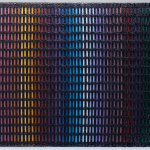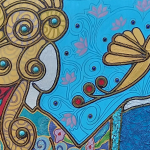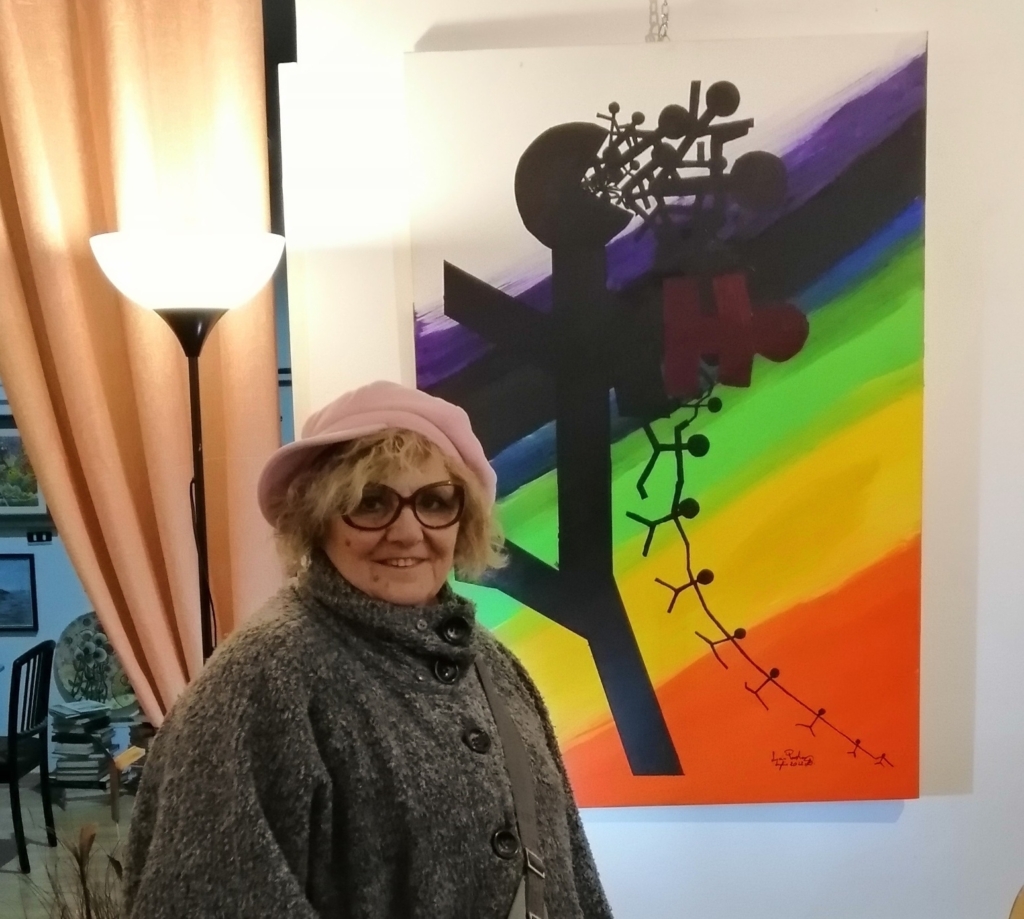
La personalità artistica spesso si allinea alla caratteristica più o meno manifesta della natura profonda dell’autore di un’opera, in alcuni casi mostrando quanto soffermarsi solo su un’espressione creativa o su un solo materiale appaia limitante in virtù di un eclettismo, di una poliedricità che ha bisogno di spaziare, di sentirsi libera di tentare strade differenti e di accettare sfide creative in grado di completare il percorso esplorativo di un artista. È questa la prerogativa più evidente dell’artista toscana Lucia Pecchia, la quale dopo essersi diplomata presso l’Istituto d’Arte di Pisa frequenta in maniera discontinua corsi di pittura presso l’Accademia d’Arte tenuti dal maestro Bruno Pollacci; la realtà è che all’epoca la sua curiosità la spingeva a tentare strade inesplorate negli studi tradizionali, non voleva appartenere a un solo genere espressivo. Il suo bisogno di autonomia la guida verso la scultura in ceramica, l’incisione e la decorazione del vetro, intaglio e decorazione su legno, creazione di oggettistica varia, tutti oggetti che poi dipinge secondo differenti stili sulla base dell’estro del momento; perché in fondo, come d’altronde avevano già anticipato i maestri dell’Arts and Crafts e della successiva Art Nouveau, tutto il lavoro artigianale può interagire ed essere trasformato in arte. Tuttavia la sua poliedricità non le impedisce di rimanere anche legata alla tela che però approccia in modo assolutamente personale, originale come d’altronde lo è la sua spiccata personalità, mostrando un tratto stilizzato attraverso il quale ironizza sull’uomo contemporaneo, lasciandone emergere i limiti e azzerandone tutte quelle complessità che sembrano imbrigliarlo nella sua esistenza ma da cui sarebbe facile uscire scegliendo di epurare la mentalità da tutti i paradigmi moderni tornando indietro verso una semplicità ormai dimenticata. Ciò che emerge in modo chiaro nelle tele di Lucia Pecchia è la convinzione che l’essere umano non possa sopravvivere in solitudine, poiché per sua stessa natura ha bisogno della socialità, dell’unione in grado di generare positività, speranza, cambiamenti altrimenti inconcepibili. Nell’opera Dualità
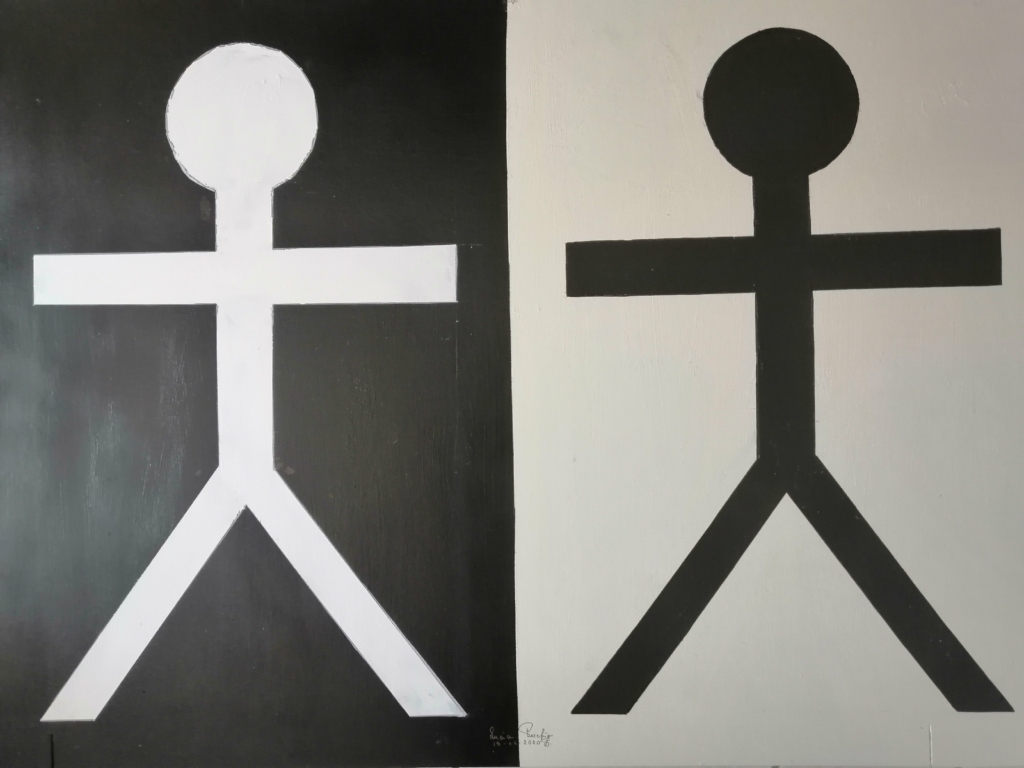
l’artista sottolinea quanto, malgrado le diversità rappresentate dal bianco e nero delle due figure protagoniste, non sia possibile prescindere dall’altro che può essere interpretato come la parte in ombra del sé, quella contrapposizione inevitabile che ciascun individuo vive, spesso combattendo quello che ritiene essere il lato debole o quello da tenere nascosto nel timore che non venga accettato, sia come apertura verso la diversità, la capacità di accogliere l’altro non più come un antagonista, qualcuno da cui proteggersi, bensì semplicemente una persona diversa e distinta con abitudini, pensieri, basi culturali e religiose differenti dalle nostre ma non per questo in contrasto con noi e con tutte le nostre certezze. La semplificazione del bianco e del nero è funzionale al messaggio, quello di non soffermarsi su sfumature che in alcuni casi tendono solo a confondere idee e pensieri, bensì focalizzarsi sull’essenza spesso dispersa e soffocata dalle tante voci dissonanti che sembrano assalire la vita moderna. Nel lavoro Insieme si può
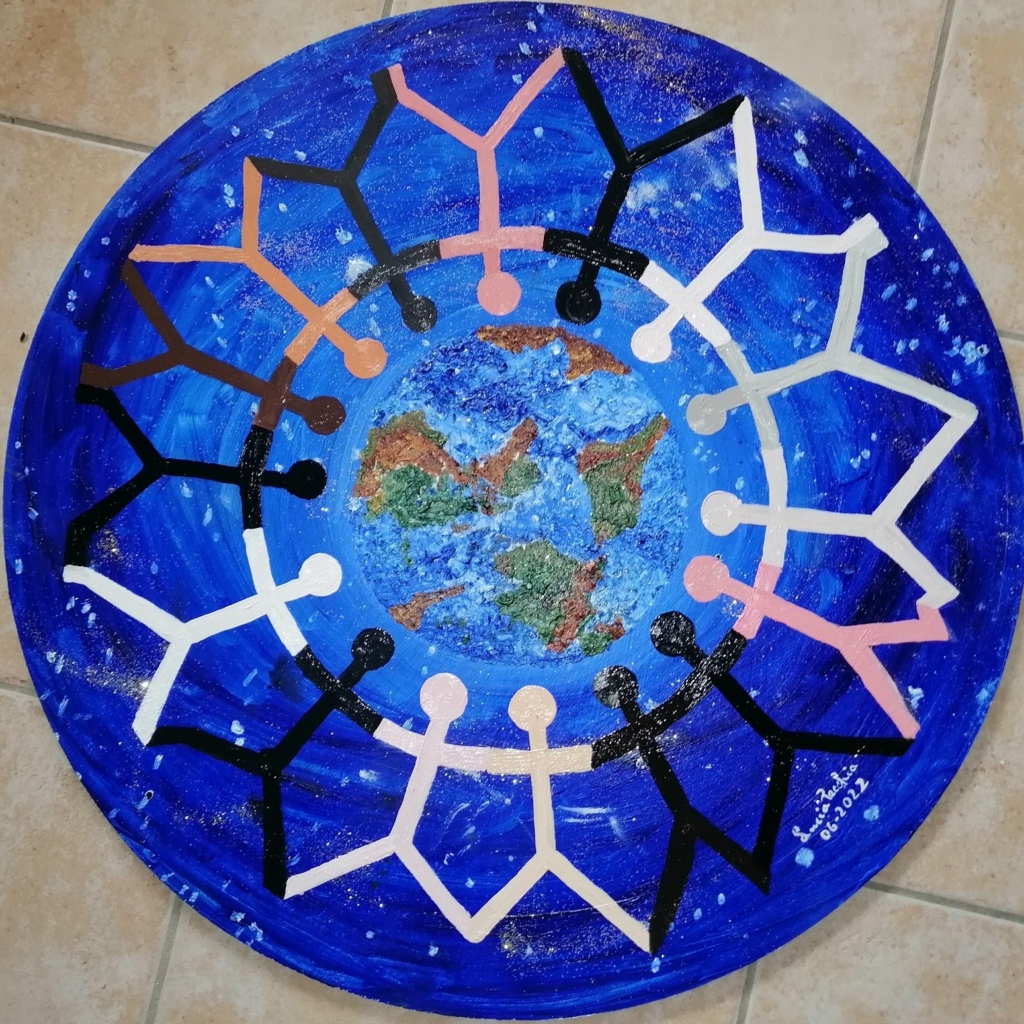
questo concetto viene amplificato, viene allargato alla comunità, alla possibilità che da sempre appartiene all’uomo di unirsi, di associarsi per perseguire un obiettivo comune, quello di costruire un mondo nuovo perché in fondo, come già evidenziato molti anni fa, le persone hanno in mano la forza; è questa l’unione di cui parla Lucia Pecchia nel titolo, tutto ciò che da soli è inimmaginabile, attraverso la coesione, la connessione e la socialità diventa invece un obiettivo non solo perseguibile, ma addirittura facilmente raggiungibile. Il concetto di questa tela dove il pianeta terra è protagonista al centro del cerchio di persone, si amplia al tema dell’ecologia per sensibilizzare l’osservatore sulla necessità di proteggere quel mondo che abitiamo e che spesso viene maltrattato e calpestato a causa dell’arrivismo e della poca lungimiranza dell’umanità. La materia spesso si amalgama alla pittura nelle tele di Lucia Pecchia che andremo ora a conoscere meglio attraverso questa intervista.
Lucia, lei ha un approccio decisamente poliedrico nei confronti dell’arte; quanto è stato importante lo sguardo innovativo dell’Arts and Crafts per liberare e sinergizzare l’espressione creativa all’artigianato? La materia è essenziale nel suo percorso, sia come base esecutiva sia come linguaggio da associare alla pittura, ci parla del motivo per il quale si sente attratta proprio dall’interazione tra colore e materia?
Negli anni Settanta c’era la necessità di portare l’arte oltre ciò che era sempre stato per secoli, adeguarla alle nuove esigenze della rivoluzione industriale ed alle conseguenti forme pubblicitarie. Nel mio tipo di Istituto d’Arte, in quegli anni, i tre anni classici, per quanto mi riguarda con specializzazione sul vetro, dovevano essere seguiti da due anni di sperimentazione sulle arti applicate tanto che il Diploma era in Arti Applicate. In realtà io avrei desiderato fare pittura ma a quel tempo i miei genitori non mi vollero permettere di studiare fuori Pisa e così mi iscrissi all'”Istituto Statale d’Arte di Pisa, l’odierno Liceo F. Russoli. Sono stata molto contenta di avere intrapreso questo percorso perché la molteplicità delle materie mi ha aperto molto la mente e mi ha aiutata a vedere il mondo nella sua complessità; devo ringraziare di avere avuto degli insegnanti molto validi. Tutta questa molteplicità di informazioni, nel tempo, mi ha portata a elaborare le mie creazioni, all’inizio confuse, poi sempre più delineate.

Nel corso del tempo ha prodotto ceramiche, oggettistica, ha realizzato sculture in vetro, e poi ovviamente non ha mai abbandonato la tela. Con quale di queste superfici si sente più a suo agio? Quale sente più affine alla sua personalità espressiva?
La materia che sento più affine a me è la pittura, amo moltissimo il colore ed il gesto della pennellata tuttavia ho bisogno di variare non solo nelle altre attività artistiche ma anche nella stessa forma di rappresentazione pittorica.
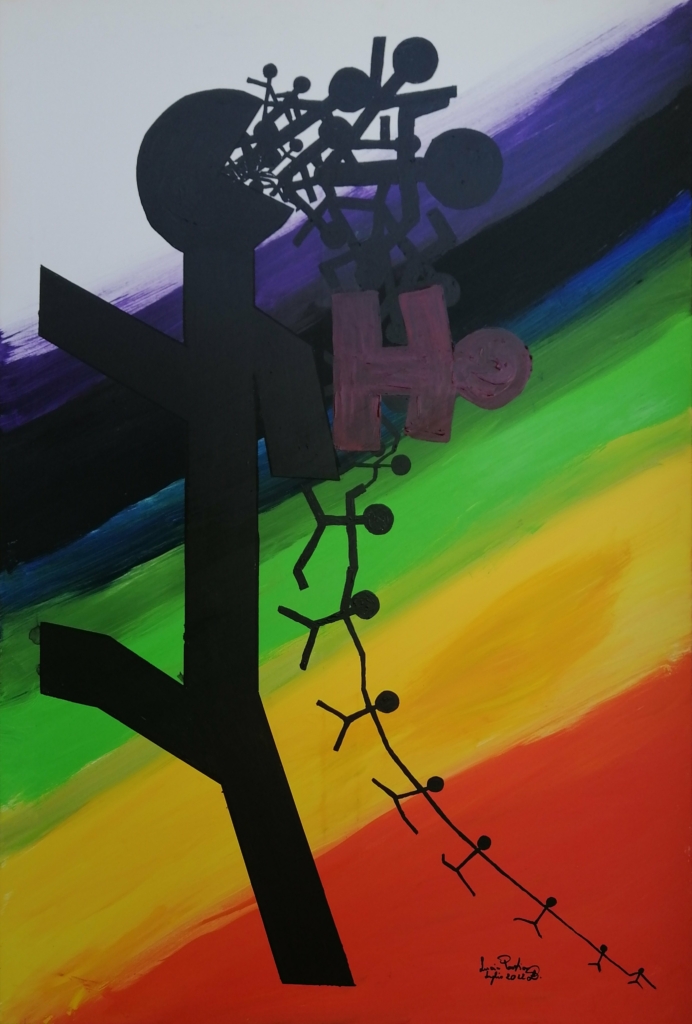
Parliamo ora della pittura, lei è passata da uno stile decisamente Informale materico a una stilizzazione sempre più evidente che la avvicina in qualche modo all’Arte Tribale con un forte simbolismo. Crede che la semplicità dell’immagine riesca a far giungere il messaggio in modo più chiaro e diretto? Quanto bisogno c’è nell’era contemporanea di recuperare la capacità di comunicare e interagire in maniera naturale e spontanea?
La pittura simbolica, che io definisco la serie degli Omini, la uso per esprimere concetti perché la forma così essenziale da essere scambiata per infantile, insieme al colore, è alla base del messaggio pubblicitario e quindi immediato da recepire. Credo che se ognuno di noi si spogliasse di tutte o molte impalcature che ci costruiamo sarebbe molto più semplice vivere e potremmo fare veramente qualcosa di valido per tutti noi e per il nostro pianeta.
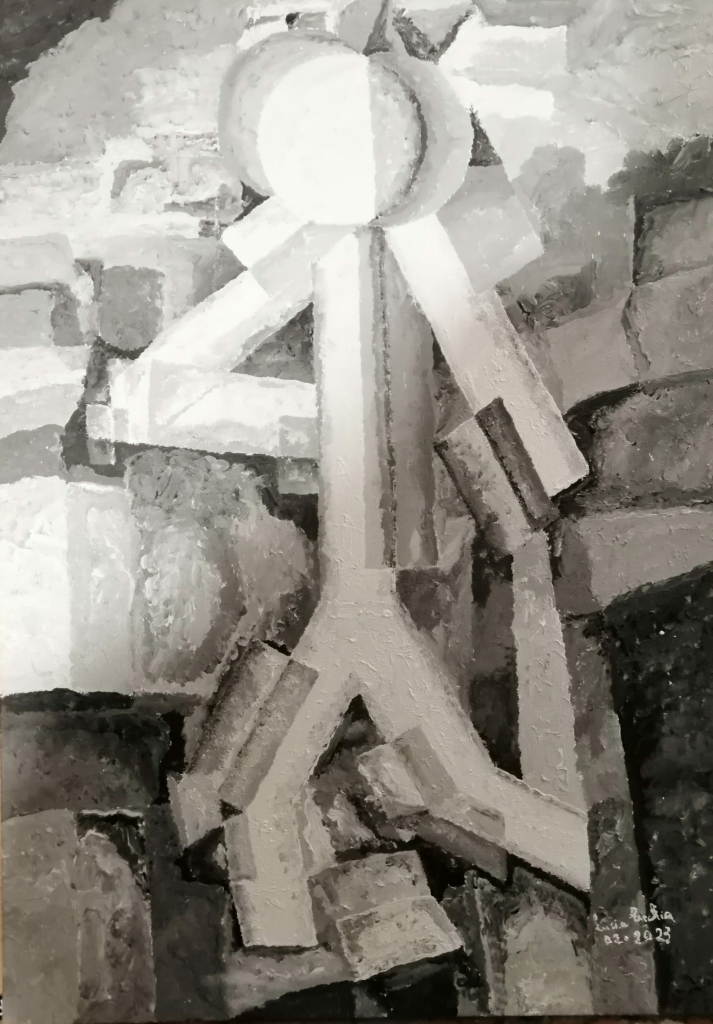
Quali sono i maestri del passato che l’hanno ispirata? Quali gli stili pittorici che hanno determinato le sue scelte artistiche?
La corrente pittorica che più mi ha attratto è l’Impressionismo e poi lo stile particolare di Toulouse-Lautrec. Mi ha sempre affascinata il Classicismo, in particolare nella scultura e nell’architettura. Sono anche molto appassionata di Arte Egizia.
Lei ha al suo attivo numerose mostre collettive in Italia e all’estero e ha vinto diversi premi. Quali sono stati i riconoscimenti che l’hanno emozionata di più? Ci racconta i suoi prossimi progetti?
Nel mio trascorso artistico sono due i riconoscimenti che mi hanno dato una forte emozione fino alla commozione, entrambi a Firenze: il secondo premio Fiorino d’Argento nell’anno 2016 a Palazzo Vecchio con l’esposizione dell’opera nella sala dei Cinquecento ed il Primo Premio all’Accademia d’Arte nell’anno 2018. In questo periodo sono presente con un quadro a Stoccolma con Interartex e prossimamente in Spagna con Art Luxory di Milano dove ci sarà una collettiva in onore di Picasso. Ultimamente sento la necessità di esprimermi tramite la scultura e l’acquarello, quest’ultimo da perfezionare dopo averlo accantonato per molti anni.
LUCIA PECCHIA-CONTATTI
Email: lucia.pecchia@virgilio.it
Sito web: https://www.pitturiamo.com/it/pittore-contemporaneo/lucia-pecchia-13959.html
Facebook: https://www.facebook.com/lucia.pecchia.1
Instagram: https://www.instagram.com/lucia.pecchia.1/
Marta Lock’s interviews: Lucia Pecchia, when creativity needs to manifest itself in various forms
The artistic personality often aligns itself with the more or less manifest characteristic of the profound nature of the author of an artwork, in some cases showing how dwelling only on a single creative expression or material appears limiting by virtue of an eclecticism, a multifacetedness that needs to range, to feel free to try different paths and to accept creative challenges capable of completing an artist’s exploratory journey. This is the most evident prerogative of the Tuscan artist Lucia Pecchia, who, after graduating from the Art Institute of Pisa, discontinuously attended painting courses at the Art Academy held by Maestro Bruno Pollacci; the reality is that at the time, her curiosity drove her to try unexplored paths in traditional studies, she did not want to belong to a single expressive genre. Her need for autonomy guided her towards ceramic sculpture, glass engraving and decoration, wood carving and decoration, and the creation of various objects, all of which she then painted according to different styles based on the inspiration of the moment; because after all, as the masters of Arts and Crafts and later Art Nouveau had already anticipated, all craftwork can interact and be transformed into art. However, her multifaceted nature does not prevent her from remaining bound to the canvas, which she approaches in an absolutely personal and original manner, as is her strong personality, showing a stylised trait through which she makes fun of contemporary man, revealing his limitations and removing all those complexities that seem to bind him in his existence but from which it would be easy to escape by choosing to purge his mentality of all modern paradigms, returning to a now-forgotten simplicity. What emerges clearly in Lucia Pecchia’s canvases is the conviction that the human being cannot survive in solitude, since by its very nature it needs sociality, the union capable of generating positivity, hope, changes otherwise inconceivable. In the artwork Duality, the artist emphasises how, despite the differences represented by the black and white of the two protagonist figures, it is not possible to disregard the other, which can be interpreted as the shadowy part of the self, that inevitable contraposition that each individual experiences, often fighting what he considers to be the weak side or the side to be kept hidden for fear that it will not be accepted, both as openness to diversity, the ability to welcome the other no longer as an antagonist, someone to be protected from, but simply a different and distinct person with habits, thoughts, cultural and religious bases different from our own but not for this reason in contrast with us and all our certainties. The simplification of black and white is functional to the message, that of not dwelling on nuances that in some cases only tend to confuse ideas and thoughts, but rather focusing on the essence often dispersed and suffocated by the many dissonant voices that seem to assail modern life. In the artwork Together we can this concept is amplified, it is extended to the community, to the possibility that has always belonged to man to unite, to associate in pursuit of a common goal, that of building a new world because after all, as already pointed out many years ago, people hold the strength in their hands; this is the union Lucia Pecchia speaks of in the title, everything that alone is unimaginable, through cohesion, connection and sociality instead becomes a goal that is not only pursuable, but even easily attainable. The concept of this canvas, where planet earth is the protagonist at the centre of the circle of people, expands on the theme of ecology to make the observer aware of the need to protect the world we inhabit, which is often mistreated and trampled underfoot due to human careerism and short-sightedness. Matter often blends with painting in Lucia Pecchia’s canvases, which we will now get to know better through this interview.
Lucia, you have a decidedly multifaceted approach to art; how important was the innovative gaze of Arts and Crafts to liberate and synergise creative expression with craftsmanship? Matter is essential in your path, both as a basis for execution and as a language to be associated with painting; can you tell us why you feel drawn precisely to the interaction between colour and matter?
In the 1970s, there was a need to take art beyond what it had always been for centuries, to adapt it to the new demands of the industrial revolution and the resulting forms of advertising. In my type of Art Institute in those years, the three classical years, as far as I was concerned with a specialisation in glass, had to be followed by two years of experimentation in applied arts so that the Diploma was in Applied Arts. Actually, I would have liked to study painting, but at that time my parents did not want to allow me to study outside Pisa, so I enrolled at the Istituto Statale d’Arte di Pisa, today’s Liceo F. Russoli. I was very happy to have taken this path because the multiplicity of subjects opened my mind a lot and helped me to see the world in all its complexity; I have to thank that I had very good teachers. All this multiplicity of information, over time, has led me to elaborate my creations, at first confused, then increasingly delineated.
In the course of time you have produced ceramics, objects, made glass sculptures, and then of course never abandoned the canvas. Which of these surfaces do you feel most comfortable with? Which one do you feel most akin to your expressive personality?
The subject I feel most akin to me is painting, I love colour and the gesture of the brushstroke very much, yet I need to vary not only in other artistic activities but also in the form of pictorial representation itself.
Let us now talk about painting, you have moved from a decidedly Informal material style to an increasingly obvious stylisation that brings you somewhat closer to Tribal Art with strong symbolism. Do you believe that the simplicity of the image succeeds in conveying the message more clearly and directly? How much need is there in the contemporary era to recover the ability to communicate and interact in a natural and spontaneous manner?
Symbolic painting, which I call the Little Men series, I use it to express concepts because the form that is so essential to be mistaken for childishness, together with colour, is the basis of the advertising message and therefore immediate to be understood. I believe that if each of us stripped ourselves of all or most of the scaffolding we build for ourselves, it would be much easier to live and we could really do something good for all of us and for our planet.
Which masters of the past have inspired you? Which painting styles have determined your artistic choices?
The pictorial current that attracted me the most is Impressionism and then the particular style of Toulouse-Lautrec. I have always been fascinated by Classicism, particularly in sculpture and architecture. I am also very passionate about Egyptian Art.
You have numerous group exhibitions in Italy and abroad to your credit and have won several prizes. Which awards have excited you the most? Can you tell us about your upcoming projects?
In my artistic career, there are two awards that have moved me to tears, both in Florence: the second prize Fiorino d’Argento in the year 2016 at Palazzo Vecchio with the exhibition of the artwork in the hall of the Cinquecento and the First Prize at the Academy of Art in the year 2018. At the moment I am present with a painting in Stockholm with Interartex and soon in Spain with Art Luxory in Milan where there will be a group exhibition in honour of Picasso. Lately I feel the need to express myself through sculpture and watercolour, the latter to be perfected after having shelved it for many years.

